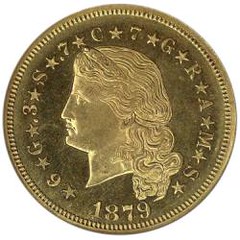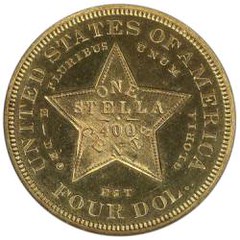
PREV ARTICLE
FULL ISSUE
PREV FULL ISSUE
FEATURED WEB PAGE: FOUR DOLLAR STELLAThis week's Featured Web Page is from the NGC site, about the Four Dollar Stella (1879-1880).
It was Kasson, though, who was behind another try at an international coinage in 1879. Attempting to appease advocates of both silver and gold, he proposed a “goloid” dollar containing 96% silver, 4% gold, and a four-dollar gold piece of 90% gold, 10% silver. The four-dollar coin was intended to compete globally with a myriad of similarly valued pieces, including the French 20 franc coin, the Spanish 20 pesetas, the Dutch and Austrian 8 florins and the Italian 20 lire. The four-dollar coin received an entirely new designation: “stella” (Latin for star). This was analogous to the eagle, “both the star and the eagle being national emblems on our coins.” Like the ten-dollar eagle and its smaller and larger counterparts, the stella was to be another denominational unit, and other coins would be expressed in fractions or multiples of it. Along with the stella, patterns for the “goloid” dollar and a “quintuple stella” (metric double-eagle) were struck in 1879. There were two obverse designs for the stella—one with Flowing Hair engraved by Charles Barber and another with Coiled Hair by George Morgan. Barber’s design depicts Liberty with long, flowing hair; Morgan’s version differs only in that Liberty’s hair is tied in a bun. On both designs, Liberty is encircled by the lettering *6*G*.3*S*.7*C*7*G*R*A*M*S*, stating the proportions of gold, silver and copper in the coin. The reverse features a large five-pointed star as the central motif, with the incuse inscription ONE /STELLA/400/CENT. Both the U.S. motto E PLURIBUS UNUM and the Latin motto DEO EST GLORIA (God is Glorious) circle the star, in turn surrounded by the inscriptions UNITED STATES OF AMERICA and FOUR DOL. The stella never saw regular production; Congress killed the legislation and only patterns were made, all proofs.


www.ngccoin.com/NGCCoinExplorer/SubCategory.aspx
|
